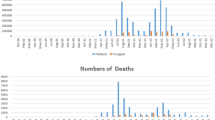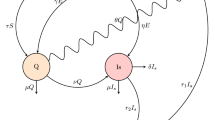Abstract
The defined epidemiological model system explaining the spread of infectious diseases characterized with SARS-CoV-2 is analysed. The resulting SEIQR model is analysed in a closed system. It considers the basic reproductive value, the equilibrium point, local subclinical stability of the disease-free equilibrium point and local subclinical stability of the endemic equilibrium point. This is examined and the asymptotic dynamics of the appropriate model system are investigated. Further, a sensitivity analysis supplemented by simulations is prepared in advance to impose how changes in parameters involve the dynamic behaviours of the model.






Similar content being viewed by others
Explore related subjects
Discover the latest articles and news from researchers in related subjects, suggested using machine learning.Data availability
The data used to support the findings of this study are available from the corresponding author request.
References
WHO: Coronavirus disease 2019 (COVID-19). Situation report 202251. (2022)
Bureau of Epidemiology. Department of Disease Control, Ministry of Public Health. Thailand 2022. Available form: http://www.boe.moph.go.th/fact/Covid-19.htm
Moore, S.E., Okyere, E.: Controlling the transmission dynamics of COVID-19. Commun. Math. Biol. Neurosci. 2022, 1–13 (2022)
Fang, Y., Nie, Y., Penny, M.: Transmission dynamics of outbreak and effectiveness of government interventions: a data-driven analysis. J. Med. Virol. 92, 645–659 (2020). https://doi.org/10.1002/jmv.25750
Liu, Z., Magal, P., Seydi, O., Webb, G.: Understanding unreported cases in the 2019-nCov epidemic outbreak in Wuhan, China and the importance of major public health interventions. Biology 9, 50 (2020). https://doi.org/10.3390/biology9030050
Daw, M.A.: Modelling the epidemic spread of COVID-19 virus infection in Northern African countries. Travel Med. Infect. Dis. 2020(35), 101671 (2020). https://doi.org/10.1016/j.tmaid.2020.101671
Unlu, U., Yalcin, N., Avsarlıgil, N.: Analysis of efficiency and productivity of commercial banks in Turkey pre- and during COVID-19 with an Integrated MCDM approach. Mathematics 10(13), 2300 (2022). https://doi.org/10.3390/math10132300
Harir, A., Malliani, S., et al.: Solutions of conformable fractional-order SIR epidemic model. Int. J. Diff. Equ. 2021, 7 (2021). https://doi.org/10.1155/2021/6636686
Sookaromdee, P., Wiwanitkit, V., et al.: Imported cases of 2019-novel coronavirus (2019-ncov) infections in Thailand: mathematical modelling of the outbreak. Asian Pac J Trop Med 13(3), 139–140 (2020)
Cruz-Lopez, Flora, Garza-González, Elvira, et al.: Analysis of influenza and dengue cases in Mexico before and during the COVID-19 pandemic. Infect. Dis. (2021). https://doi.org/10.1080/23744235.2021.1999496
Deborah, D.: Mathematical model for the transmission of Covid -19 with nonlinear forces of infection and the need for prevention measure in Nigeria. J. Infect. Dis. Epidemiol. 6(5), 158 (2020). https://doi.org/10.23937/2474-3658/1510158
Khader, M.M., Adel, M.: Modeling and numerical simulation for covering the fractional COVID-19 model using spectral collocation-optimization algorithm. Fractal Fract. 6, 363 (2022). https://doi.org/10.3390/fractalfract6070363
Liu, G., Chen, J., Liang, Z., Peng, Z., Li, J.: Dynamical analysis and optimal control for a SEIR model based on virus mutation in WSNs. Mathematics 9, 929 (2021). https://doi.org/10.3390/math9090929
Martinot, M., Schieber, A., et al.: Clinical features and outcomes in adults with COVID-19 during the pre-omicron and omicron waves. Infect. Dis. 2024(54), 104833 (2024). https://doi.org/10.1016/j.idnow.2023.104833
Harir, A., Melliani, S., et al.: Variational iteration method and differential transformation method for solving the SEIR epidemic model. Int. J. Diff. Equ. 2020, 7 (2020). https://doi.org/10.1155/2020/3521936
Sungchasit, R., Tang, I.M., Pongsumpun, P.: Mathematical modeling: Global stability analysis of super spreading transmission of respiratory syncytial virus (RSV) disease. Computation 10(7), 120 (2022). https://doi.org/10.3390/computation10070120
Mwalili, S., Kimathi, M., Ojiambo, V., Gathungu, D., Mbogo, R.: SEIR model for COVID-19 dynamics incorporating the environment and social distancing. BMC Res. Notes 13(1), 352 (2020). https://doi.org/10.1186/s13104-020-05192-1
Wintachai, P., Prathom, K.: Stability analysis of SEIR model related to efficiency of vaccines for COVID-19 situation. Heliyon 7(4), E06812 (2021). https://doi.org/10.1016/j.heliyon.2021.e06812
Chen, T.M., et al.: Mathematical model for simulating the phase-based transmissibility of a novel coronavirus. Infect. Dis. Poverty 9, 24 (2020)
Riyapan, P., Shuaib, S.E., Intarasit, A.: A mathematical model of COVID-19 pandemic: a case study of Bangkok, Thailand. Comput. Math. Methods Med. 2021(1), 11 (2021). https://doi.org/10.1155/2021/6664483
Sameni, R.: Mathematical modeling of epidemic diseases; a case study of the COVID-19 coronavirus. arXiv: 2003.11371v3[q-bio.PE] 19 May 2020
Kim, B.N., Kim, E., Lee, S., Oh, C.: Mathematical model of COVID-19 transmission dynamics in South Korea: the impacts of travel restrictions, social distancing, and early detection. Processes 8(10), 1304 (2020). https://doi.org/10.3390/pr8101304
Sharma, S., Volpert, V., Banerjee, M.: Extended SEIQR type model for COVID-19 epidemic and data analysis. Math. Biosci. Eng. 17(6), 7562–7604 (2020). https://doi.org/10.3934/mbe.2020386
Brauer, F., Castillo-Chavez, C.: Mathematical models in population biology and epidemiology. Springer, New York, NY (2012)
Busenberg, S., Cooke, K.: Vertically transmitted disease. Springer, Berlin, Heidelberg (1993)
Cruz-Pacheco, G., Esteva, L., Montano, J.A., Vargas, C.: A Mathematical model for the dynamics of west Nile Virus. IFAC Proc. Vol 37(21), 475–480 (2004)
van den Driessche, P., Watmough, James: Reproduction numbers and sub-threshold endemic equilibria for compartmental models of disease transmission. Math. Biosci. 180(1–2), 29–48 (2002)
Nainggolan, J., Ansori, M.F.: Stability and sensitivity analysis of the COVID-19 spread with comorbid diseases. Symmetry 14, 2269 (2022). https://doi.org/10.3390/sym14112269
Dielman, D., Heesterbeek, J.: Mathematical epidemiology of infectious disease: model building analysis and interpretation. Wiley Series in Mathematical and Computation Biology. Wiley, Chichester (2000)
Olaniyi, S., Lawal, M.A., Obabiyi, O.S.: Stability and sensitivity analysis of a deterministic epidemiological model with pseudo-recovery. IAENG Int. J. Appl. Math. 46(2), 160–167 (2016)
Naik, P.A., Owolabi, K.M., Zu, J., Naik, M.U.D.: Modeling the transmission dynamics of COVID-19 pandemic in caputo type fractional derivative. J. Multiscale Model. 12(03), 2150006 (2021). https://doi.org/10.1142/S1756973721500062
Karaagac, B., Owolabi, K.M., Pindza, E.: A computational technique for the Caputo fractal-fractional diabetes mellitus model without genetic factors. Int. J. Dyn. Control 11, 2161–2178 (2023). https://doi.org/10.1007/s40435-023-01131-7
Bhatter, S., Jangid, K., Abidemi, A., Owolabi, K.M., Purohit, S.D.: A new fractional mathematical model to study the impact of vaccination on COVID-19 outbreaks. Decis. Anal. J. 6, 100156 (2023). https://doi.org/10.1016/j.dajour.2022.100156
Mishra, A.M., Purohit, S.D., Owolabi, K.M., Sharma, Y.D.: A nonlinear epidemiological model considering asymptotic and quarantine classes for SARS CoV-2 virus. Chaos, Solitons Fractals 138, 109953 (2020). https://doi.org/10.1016/j.chaos.2020.109953
Idisi, O.I., Yusuf, T.T., et al.: A bifurcation analysis and model of Covid-19 transmission dynamics with post-vaccination infection impact. Healthcare Anal. 2023(3), 100157 (2023). https://doi.org/10.1016/j.health.2023.100157
Acknowledgements
The authors thank the handling editor and anonymous referees for their valuable comments and suggestions which led to an improvement of our original paper. The first author would like to thank Research and Development Institute and Faculty of Science and Technology, Phuket Rajabhat University. The second author was supported by King Mongkut’s Institute of Technology Ladkrabang.
Author information
Authors and Affiliations
Corresponding author
Ethics declarations
Conflict of interest
The authors declare that there are no conflicts of interest regarding the publication of this paper.
Additional information
Publisher's Note
Springer Nature remains neutral with regard to jurisdictional claims in published maps and institutional affiliations.
Rights and permissions
Springer Nature or its licensor (e.g. a society or other partner) holds exclusive rights to this article under a publishing agreement with the author(s) or other rightsholder(s); author self-archiving of the accepted manuscript version of this article is solely governed by the terms of such publishing agreement and applicable law.
About this article
Cite this article
Sungchasit, R., Pongsumpun, P. Mathematical modeling and stability of SARS-CoV-2 transmission dynamics among domestic tourists in Thailand. J. Appl. Math. Comput. 71, 173–202 (2025). https://doi.org/10.1007/s12190-024-02228-8
Received:
Revised:
Accepted:
Published:
Issue Date:
DOI: https://doi.org/10.1007/s12190-024-02228-8




